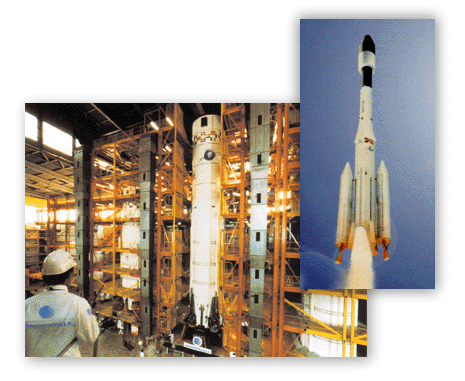| Aerospatiale's
CATIA users are flying high with a Distributed File System from IBM "DFS provides the performance, cross-site
replication and security that is critical to our competitiveness."
Jean-Pierre Margeot
The Aerospatiale group is a world
leading designer and manufacturer of aeronautical and aerospace systems. As a FF 55
billion ($10 billion) company operating in a highly competitive international marketplace,
Aerospatiale must give top priority to the efficiency and security of its engineering
processes. Thanks to IBM's Enhanced Distributed File System (DFS), Aerospatiale's
engineering department has achieved the level of file system performance, efficiency and
security it needs to remain on the leading edge of its field.
The challenge: sharing CATIA files in
a distributed environment
A recent engineering project at Aerospatiale required collaboration between engineers at
two sites. One site is located at Les Mureaux, near Paris, and the other is 500 kilometers
away, at Bordeaux.
The engineers at both sites rely heavily
on Dassault's CATIA/CADAM computer-aided design products to support their team's design
processes. These processes require that engineers be able to share data with their remote
colleagues in real time. As drawings are completed, they need to be made available to all
the other members of the team, at both sites.
The completed CATIA files, typically up
to 100 Mbytes each, reside on an IBM RS/6000 390 server and a Sun Enterprise 4008 server
at the Les Mureaux site, and on an RS/6000 42T server at the Bordeaux site. A 2 Mbps
leased line connects the two sites.
Seeking a solution for large files,
wide-area distribution
Before deciding on a DCE solution, the engineering department considered other file
sharing schemes, but found that their performance over the wide-area link was
unacceptable. "And, since they did not perform file replication," Margeot says,
"We would have had to write our own code to carry out this function. Even with the
code, maintaining updated versions of the shared files at both sites would create
considerable administrative overhead. As engineers at each site complete their drawings,
they would have to date them and manually transmit them to the other side."
Providing security for the CATIA data
was also a concern. With the other approaches that Margeot's team evaluated, there was no
robust mechanism for protecting these valuable assets, both in storage on the servers and
in transmission across the local and wide area networks.
At this point, Margeot says, "There
was no file sharing system between the two sites, because it was impossible to
maintain."

IBM provided much-needed experience
in DCE-DFS
Looking for a comprehensive solution to these problems, Aerospatiale welcomed IBM's DFS.
"We were interested in the DCE-DFS concept, but it was very hard to find someone in
France who was familiar with the technology," Margeot says. "We found that IBM
not only understood our vision for DFS, but also had the experience necessary to implement
it."
That experience contributed to a smooth
DFS implementation. "Everything went very quickly," Margeot recalls. "The
CATIA users presented their problem to us at the end of October, and we found the solution
and had the installation working by the following January."
DFS makes access easy for users,
difficult for intruders
For Aerospatiale, the benefits of working with DFS are threefold: "DFS provides the
performance, cross-site replication and security that is critical to our
competitiveness," Margeot says.
Aerospatiale's measure of good
performance is the ability of users to access data at a remote site as easily as if it
resided on their local server. At the same time, the data they access must be synchronized
with the master files on the remote server. But the CATIA files are too large to be kept
synchronized across the wide area link using file transfer.
The DFS replication mechanism provides a
key capability in allowing data on the servers at each site to be mirrored on the servers
at the other site. This not only ensures real time data synchronization, but also
minimizes traffic over the wide area link.
Aerospatiale has also benefited from
DFS's client caching scheme, which keeps the majority of the read/write operations on the
local workstation. "After initial data access," Margeot notes, "users
benefit from the performance of their local disk, regardless of whether the master copy of
the data resides on the local or the remote DFS server."
DFS takes advantage of DCE's Access
Control Lists (ACLs) to protect the CATIA files from unauthorized access and updates. And
its authentication mechanism is based on Kerberos Version 5, a third-party private key
technology.
The right file system for a wide
range of applications
According to Margeot, the DFS implementation is expanding beyond the original CATIA
application. "Our users wanted to be able to access CATIA drawings from Windows NT
servers in order to incorporate them into word processing documents and graphics files.
With IBM's DFS, they can."
UNIX servers running IDEAS and 3DX have
also been incorporated into the DFS. "As we gain experience with DFS, we find that
it's a solution worth extending to many other projects," Margeot says.
For more information please contact:
IBM Marketing Representative,
IBM Business Partner, or
IBM Direct at: 1 800 IBM CALL
For information faxed direct to your
location:
1 800 IBM 4FAX
Visit our Web site at:
http://www.software.ibm.com/enetwork/dce/
© IBM Corporation
1701 North Street
Endicott, NY 13760
Printed in the United States of America
2-97
All Rights Reserved
This brochure illustrates how one
customer uses IBM products. Many factors have contributed to the results and benefits
described. IBM does not guarantee comparable results. All information contained herein was
provided by the featured customer and IBM Business Partners. IBM does not attest to its
accuracy.
References in this publication to IBM
products or services do not imply that IBM intends to make them available outside the
United States.
IBM is the registered trademark of
International Business Machines Corporation. IBM company product and service names are
trademarks or registered trademarks of IBM. Other company, product or service names may be
trademarks or service marks of others.
|